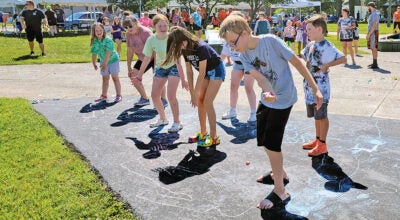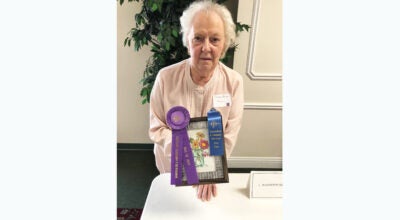PROFILE 2013: Breaking the mold
Published 12:36 am Sunday, March 3, 2013
Nannie Kelley Wright was unique woman for the ages
“Age is a quality of the mind.”
The first line of a poem by H.S. Fritsch, those words were a favorite philosophy of one of Ironton’s most notable and unique women, Nannie Kelley Wright.
Wright kept a copy of the poem in her dictionary, along with others about love, life, death and work.
“If you no longer look ahead; if your ambitions are dead, then you are old,” the poem reads. “But if in life you keep the zest; if from life you draw the best, … you are not old.”
During a time when the expectations of women were limited to child rearing, housekeeping and socializing, Nannie wasn’t interested in fitting into anyone’s mold, said Lawrence County Historical Society member Kay Rader.
Rader has portrayed the role of the woman in the annual ghost walk at Woodland Cemetery for about seven years and has become somewhat of an expert on all things Nannie.
“I love it,” Rader said. “I feel like I’m Nannie when I’m doing her. I feel she’s such an interesting character and we have so many things at the museum. She’s one of Ironton’s most favorite people.”
When Rader gets into costume for the ghost walk, she dresses how Nannie would have later in her life, with a mink stole, long black dress, hat and, of course, sparkling diamonds.
Rader said Nannie was “a lady ahead of her time,” who lived a life full of adventure and extravagance. That extravagance was made clear in the production that was her wedding.
Nannie was born in 1856 in Catlettsburg, Ky., a daughter of Capt. Washington and Catherine Honshell, one of four children born to the well-to-do couple.
When she was 23 years old, she married her first husband, Lindsey Kelley, Senator to the eighth district of Ohio, and ironmaster of Centre Furnace.
Rader said Nannie loved roses, so much so that she had 300 tuberoses delivered to decorate the church. She wore a white silk and satin dress with diamond embellishments.
From then on, it was nothing short of the most luxurious for Nannie Kelley.
“She had wonderful parties,” Rader said. “Some of her parties were catered from Cincinnati, the food brought down on a train. Everything was splendid. I’m sure hers were the best.”
Nannie and Lindsey Kelley made their first home in Ironton on the corner of Fourth and Olive streets (now Park Avenue). The couple later moved to a home on South Sixth Street. They had one son, named Lindsey Jr.
Nannie Kelley was known as a stern, abrupt woman who demanded and was willing to pay top dollar for excellent service from salespeople, servants, and later on, her employees.
“I assume she was stubborn, too,” Rader said. “She wanted her own way. And she loved children but they were very often afraid of her. She was tall and she was abrupt in her manner.”
She was also described as loving, devoted and generous to her family and friends.
In the late 1890s, Nannie Kelley further proved to me more than just a housewife. The need for iron was in a state of decline and her husband and father-in-law’s furnace closed down.
“She just thought surely things would turn around and that there would be a need for iron again,” Rader said. “She wanted that so badly and then it came about. Of course it came about with the war, and that was sad, but still I think she maybe proved a point to her husband, that she could do it.”
Rader said she has never heard of another female ironmaster.
Nannie Kelley refurbished the furnace and hired workers. She sometimes even wore a calico dress and worked alongside her employees if needed.
“They said she was very good to her employees,” Rader said. “When they were talking about unionizing she said she didn’t need a union, because she was good to her employees. It wouldn’t benefit them.”
The Spanish American War broke out in 1898 and iron was desperately needed. Nannie Kelley was one of the first ironmasters to be able to ship iron to the Great Lakes region for building ships, cannons and other military equipment.
Just a few years later, in 1903, Lindsey Kelley died of pneumonia. Less than a year after that, the couple’s only son died.
“I don’t think she had the happiest life because of becoming a widow so young and losing her only son, but she carried on,” Rader said. “So she had a very strong will and she didn’t let the public tell her how to live her life.”
By the end of 1904, Nannie Kelley had traveled to London, England, and was presented to the court of King Edward VII. She also took a world tour, the second of three that she would embark on. In all, the adventuresome woman traveled across the Atlantic Ocean 14 times in her life.
In 1906 she sold Centre Furnace to Superior Cement Company and two years later married D. Gregory Wright.
The two were said to have met in Paris and their wedding was very fashionable event, held at the First Presbyterian Church in Ironton.
Nannie continued to throw lavish parties, including one during the moving of her Sixth Street home.
Nannie decided to move the home from the corner of Sixth and Quincy streets to the corner of Sixth and Chestnut streets. She invited friends to attend a party while the house rolled down the street to its new location.
She later owned a home on South Fifth and Adams streets, which had murals painted to depict the four seasons and priceless antiques from her world travels.
When the stock market crash of 1929 hit, Wright lost most of her wealth.
“She didn’t fall to pieces,” Rader said. “She just accepted it. She was 73 years old and didn’t think she would live many more years. She didn’t dream she would live to be 90.”
Whenever she needed money, she sold personal belongings to make ends meet. She even had a cupful of unset diamond that she sold at times, Rader said.
During her remaining years, Nannie Wright rented several rooms, including one at the Frederick Hotel in Huntington, W.Va., and at the former Marting Hotel in Ironton where she died on Sept. 12, 1946, at the age of 90.
She is buried in Woodland Cemetery in a mausoleum etched with tuberoses.
Rader said, although all history is important to preserve, the life of someone as interesting as Nannie Kelley Wright is especially important.
The Lawrence County Historical Museum has a room devoted to the woman, featuring many of her personal items from her travels and her home, including her monogrammed gold-rimmed crystal dessert bowls, plates, vanity set and silver flatware.
Her walnut and brass filing cabinet and typewriter are also on display as is the dress she wore when presented to the King of England.
Over the mantle in the Nannie Kelley Wright Room is a portrait of the woman taken at her home on South Fifth Street sometime during the 1920s.
“We have pictures of the interior of her home that are very interesting,” Rader said. “They show that she was artistically inclined. She was also very devoted to her parents. We have pictures of her parents.”
As a woman who lives in Ironton and one who knows the life of Nannie Wright well, Rader said she feels a sense of pride knowing everything Wright accomplished as a woman living in a man’s world.
“I think she would have fit right in today.”





